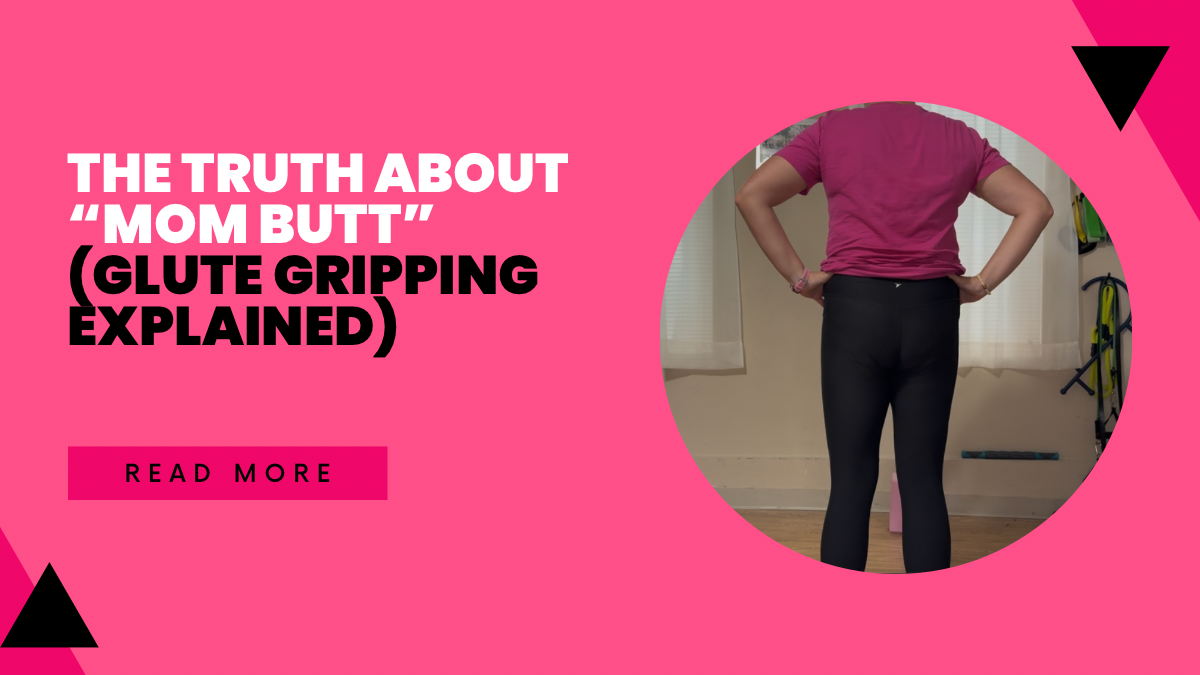The Truth About “Mom Butt” (Glute Gripping Explained)

Learn why “mom butt” or flat glutes happen after pregnancy, how glute gripping affects your body, and what to do to fix it.
If you’ve ever looked in the mirror and thought, “Wait… where did my butt go?” — you’re not alone.
Many moms notice their glutes look flatter after pregnancy or that their hips and lower back feel tighter. You might even hear the term “mom butt,” “flat butt,” or “pancake butt.” But what’s actually happening here isn’t just a cosmetic change — it’s your body adapting to how you move and hold yourself day to day.
Let’s talk about what’s really going on — and what you can do to fix it.

What Is Glute Gripping?
Glute gripping happens when the butt muscles stay constantly clenched. It’s your body’s way of finding stability — especially when your center of gravity has shifted forward.
This often happens after pregnancy (thanks to months of carrying extra weight in front), but it can also come from years of standing with your hips pushed forward, squeezing your glutes to “stand tall,” or even just adapting to holding kids on one hip.
Over time, this pattern keeps the glutes and the back of the pelvic floor tight and short. Instead of being strong and responsive, those muscles stay “on” all the time — which eventually makes them weaker.

Why It Matters (It’s Not Just About the Look)
When your glutes are constantly gripping, it changes how your entire body moves and functions.
You might notice things like:
- A flatter-looking butt (“mom butt”)
- Tailbone pain or pressure
- Constipation
- Pelvic floor tightness or pain
- Lower back discomfort
- Even harder or more painful labor
Your body is amazing at adapting — but those adaptations can cause tension that affects the pelvic floor, core, and posture over time.
The Real Fix (Hint: It’s Not More Squats)
When most people see a flatter butt, they jump straight into glute exercises like squats or bridges. But here’s the thing — if your glutes are already locked up and your posture is shifted forward, adding more tension won’t help.
Before strengthening, you have to reset.
Start by focusing on breathing and alignment drills that help bring your center of gravity back. A few of my favorites are:
- Child’s Pose Hip Shift – opens the back of the hips and lengthens tight glutes.
- 90-90 Breathing – helps reconnect the ribs, core, and pelvis.
Once your body learns where “neutral” actually is again, then it’s time to strengthen.

How to Build Strength (The Smart Way)
After you’ve restored alignment and breathing, add movements that teach your glutes and core to work together — not against each other.
Try exercises like:
- Dead bugs – connect the deep core and pelvic floor.
- Bird dogs – improve control and core stability.
- Hinges – teach proper glute engagement without over-squeezing.
The goal isn’t to “activate” your glutes — it’s to help your body move in balance again so your glutes can do their job naturally.
Bringing It All Together
If your butt feels flat, your hips feel tight, or your back always seems sore — it’s not about losing strength. It’s about how your body is using that strength.
Glute gripping is just your body trying to create stability in the best way it knows how. The good news? You can retrain it.
With the right breathing drills, mobility work, and strengthening exercises — designed for your specific body — you can shift that center of gravity back where it belongs, improve your posture, and yes, even bring that shape back to your backside.

Ready to Fix “Mom Butt” the Right Way?
If this sounds like you — tight hips, flat glutes, or a pelvic floor that doesn’t feel quite right — I’d love to help.
In my 1:1 coaching, we look at your posture, breathing, and movement patterns to design a plan that fits your body and schedule.
No endless squats. No guessing. Just a smarter way to rebuild strength from the inside out.
Categories: : Butt, fourth trimester, Pelvic Floor & Core Health, Postpartum
 Jen Landry
Jen Landry 